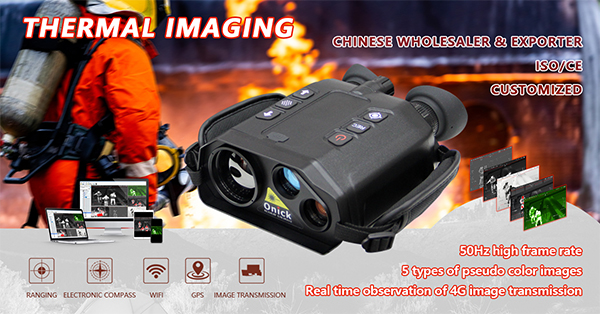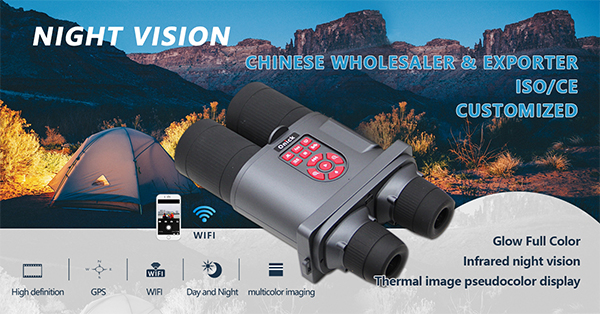With the rapid development of science and technology, thermal imaging technology has been widely used in many fields. Among them, binocular fusion thermal imaging handheld reconnaissance instruments have gradually emerged with their unique technical advantages, and have shown many excellent characteristics compared with traditional ordinary thermal imagers.
1. Accurate three-dimensional imaging and depth perception
Ordinary thermal imagers capture thermal radiation through infrared detectors to generate two-dimensional thermal images, which can only present the temperature distribution of objects and lack accurate judgment of the depth and spatial position of target objects. The binocular fusion thermal imaging handheld reconnaissance instrument uses two thermal imaging sensors to collect thermal images of the same scene from different angles, and then uses advanced computer algorithms to fuse and process the two thermal images, simulating the binocular vision system of the human eye, and calculating the depth information of the target through the difference in left and right perspectives, and then generating a thermal image in three-dimensional space.
This precise three-dimensional imaging capability is fully demonstrated in complex environments. For example, in search and rescue scenarios, when faced with smoke-filled, dimly lit or a large number of obstacles, ordinary thermal imagers may only provide blurred plane images, and rescuers find it difficult to quickly determine the exact location of trapped people. The binocular fusion thermal imaging handheld reconnaissance device can clearly present the three-dimensional position of the trapped person, including the specific position of the floor and room where the person is located, greatly improving the rescue efficiency. In the field of security monitoring, for night monitoring, ordinary thermal imagers may not be able to accurately judge the distance and position of the target object, resulting in deviations in the assessment of potential threats. The three-dimensional imaging and depth perception functions of the binocular fusion thermal imaging handheld reconnaissance device can help security personnel quickly determine the position, distance and moving direction of the target, take corresponding measures in time, and effectively improve the security response capabilities.
2. Higher target recognition rate and positioning accuracy
During dynamic monitoring, ordinary monocular thermal imagers are greatly affected by target movement or environmental changes, and are prone to misjudgment or failure to detect targets. Due to the limitations of its single perspective, it is difficult to continuously and stably track the target when the target moves quickly or the surrounding temperature changes are complex. The binocular fusion thermal imaging handheld reconnaissance device can effectively make up for this defect through multi-angle image fusion. It obtains target information from different angles, reduces errors after comprehensive analysis, greatly improves the recognition rate and accuracy of the target, and is especially suitable for tracking and positioning moving targets.

Taking military applications as an example, on the battlefield, enemy targets are often in a fast-moving state, and may use various means to camouflage and conceal. Ordinary thermal imagers may find it difficult to accurately identify and track enemy personnel and equipment in complex environments. With its multi-angle imaging and fusion technology, the binocular fusion thermal imaging handheld reconnaissance device can more accurately identify target features. Even if the target is camouflaged, it can improve the probability of identifying the target through depth information and multi-angle image analysis, and accurately locate the target position, providing a reliable basis for combat decision-making. In terms of wildlife monitoring, the activities of animals are random and agile, and ordinary thermal imagers may lose the target when the animal moves quickly. The binocular fusion thermal imaging handheld reconnaissance device can stably track the activity trajectory of animals, accurately evaluate the behavior patterns and activity range of animals, and provide more accurate data support for wildlife research.
3. Richer observation mode and visual experience
Ordinary thermal imagers usually only provide a single thermal imaging observation mode, and the image is relatively monotonous, lacking a comprehensive display of the environment and target details. The binocular fusion thermal imaging handheld reconnaissance instrument has multiple observation modes, such as the advantages of fusion of low light and thermal imaging at the same time, supporting multiple observation modes such as infrared, low light, fusion black and white, fusion color, etc. Different observation modes can meet the observation needs of different scenes and personnel.

In the night patrol law enforcement scene, the fusion color night vision mode can make the observed target more obvious, and law enforcement officers can detect the target faster and more accurately under the concealed camouflage background. The image in this mode is more natural and more in line with the human eye habits, which can significantly improve the target recognition performance of the human eye and reduce the fatigue caused by long-term observation. In some scenes where detailed observation of specific areas is required, such as industrial equipment inspection, cultural relics protection monitoring, etc., users can switch different observation modes according to actual needs to obtain richer target information and details, so as to understand the state of the observed object more comprehensively and deeply, and improve work efficiency and accuracy.
4. Better environmental adaptability and all-weather working ability
Ordinary thermal imagers may be subject to certain limitations under certain extreme environmental conditions. For example, in a high temperature environment, its own heat dissipation problem may affect the imaging quality; in a high humidity environment, water vapor condensation may occur inside the instrument, interfering with normal work. The binocular fusion thermal imaging handheld reconnaissance device fully considers environmental adaptability in its design. Through optimized heat dissipation structure and protective measures, it can work stably in harsh environments such as high temperature, high humidity, and dust.
Under harsh weather conditions, such as fog, rain, and snow, the imaging effect of ordinary thermal imagers may be weakened to a certain extent, resulting in a decrease in the clarity and recognition of the target. However, the binocular fusion thermal imaging handheld reconnaissance device uses advanced image fusion and enhancement algorithms, which can still maintain good imaging effects under these harsh weather conditions and quickly and automatically lock the target. Whether in the dark, in a completely dark and closed environment, or in harsh weather conditions, it can meet the needs of all-weather combat, patrol, law enforcement, and other work. For example, during border patrols, no matter what kind of bad weather they encounter, border guards can rely on binocular fusion thermal imaging handheld reconnaissance devices to clearly observe the surrounding environment, promptly detect potential security threats, and ensure border security.
Compared with ordinary thermal imagers, binocular fusion thermal imaging handheld reconnaissance devices have significant advantages in imaging effects, target recognition, observation modes and environmental adaptability, bringing more efficient, more accurate and more convenient solutions to applications in many fields. They are gradually becoming a powerful tool for various industries to conduct reconnaissance and monitoring in complex environments.


